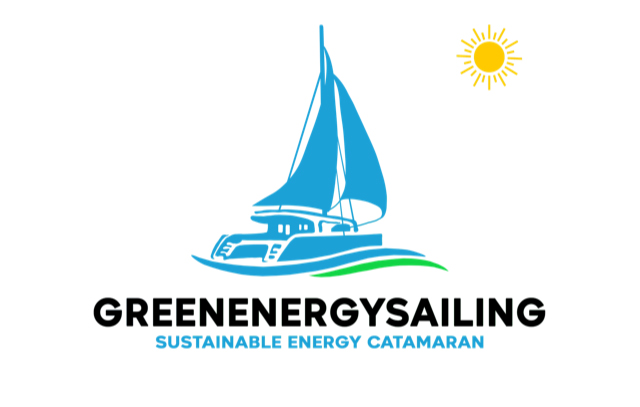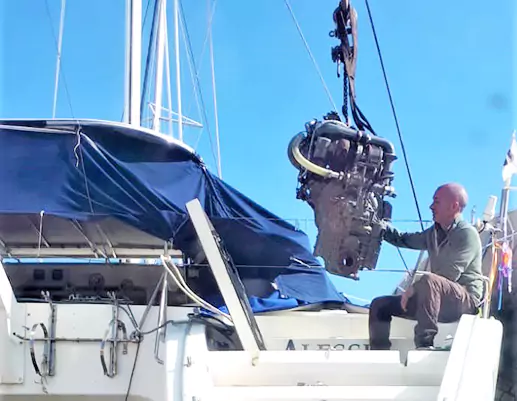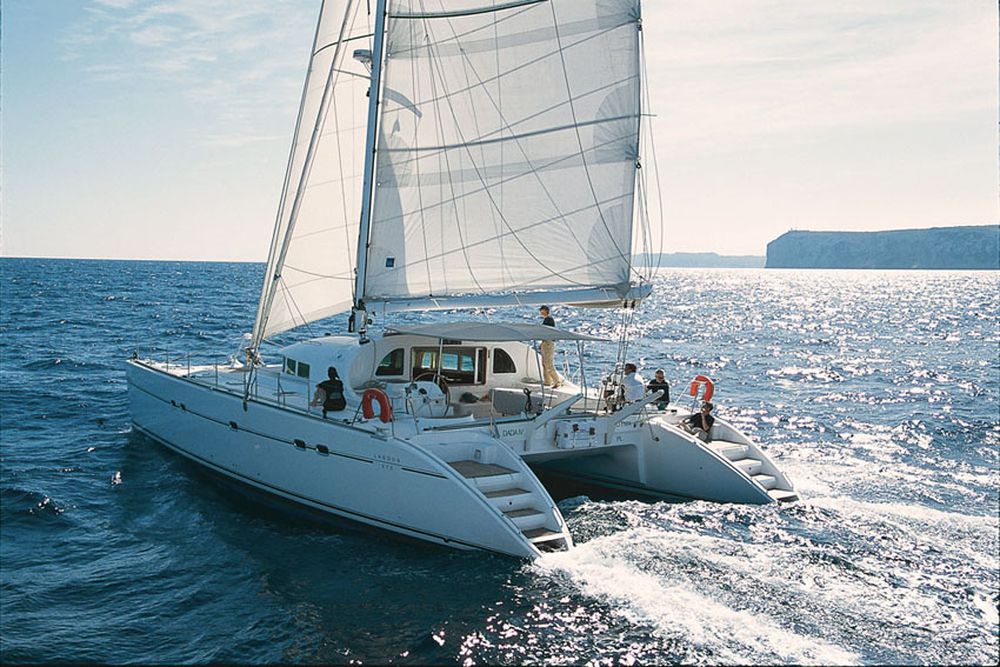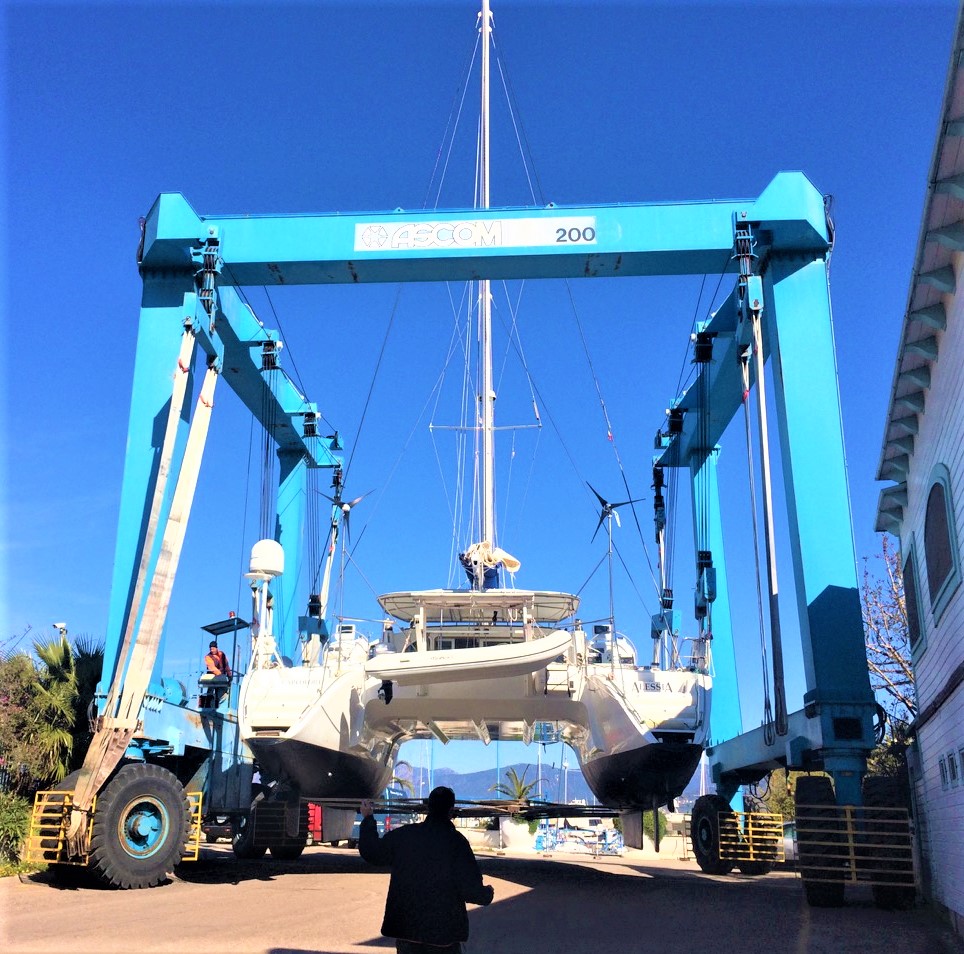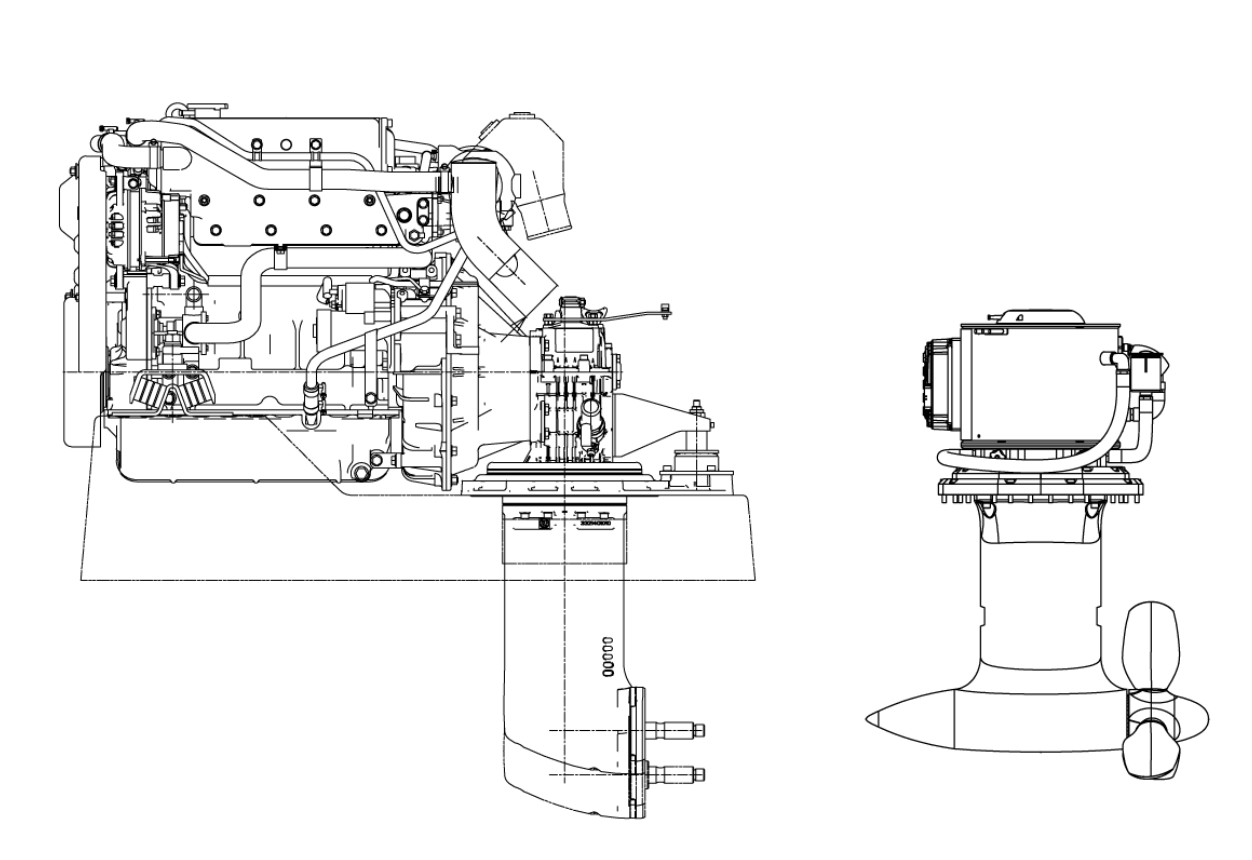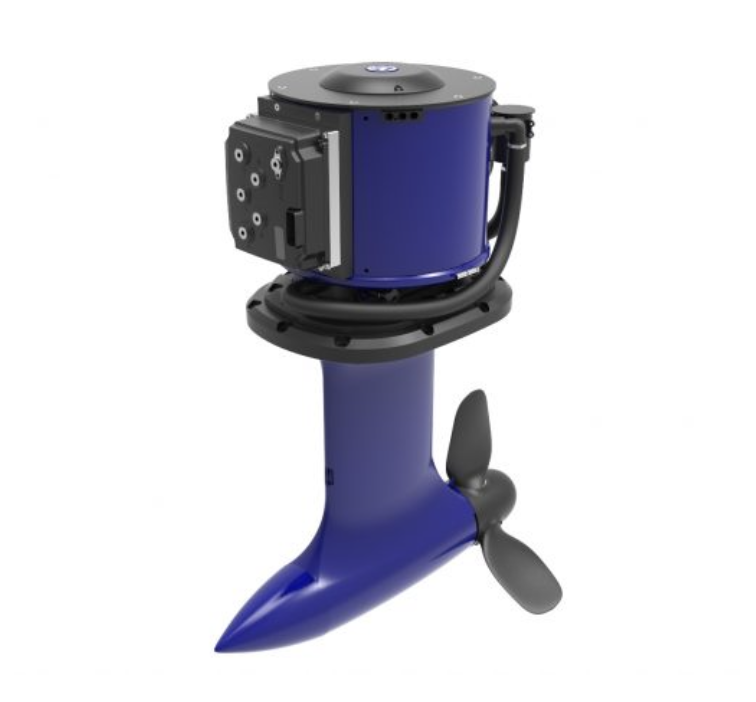The Project
Our Project Objectives
With our 17 meter Sailing Catamaran, a Lagoon 570 named ENTROPY and built by CNB in 2002, we are about to make a difference. We are “Going Green” and harvesting renewable energy from the 3 natural sources, wind, sun, and water. Sustainable electric power will be generated with a massive array of solar panels, two wind turbines and hydro-recuperation via our very efficient twin electric drive motors. We choose a pre-owned ship for this conversion, because building a new one is consuming a lot of energy and resources during the production process.
The two 110 hp Yanmar turbodiesels have already been removed. They will be replaced by two electric motors with hydro-recuperation, as well as the associated control electronics.
The 12.7 kV Onan diesel generator (350KG) has already been removed. It is replaced by a powerful Li-Ion battery bank. A small generator serves as back-up and emergency system.
The entire interior is currently being reworked and renewed. All cabinet doors and back walls, ceilings and wall panels have been removed, the skipper’s cabin removed. The galley has been extended by removing a non-structural partition wall.
Our Project
The generated energy will be managed by several MPPT charge controllers and be stored in a battery bank with a capacity of 60kWh, 48V for the propulsion and a second one of 20kWh, 48V for the hotel load. The two battery-banks are connected with each other.
- 4,5 kW rigid solar panels
- 3,0 kW flexible solar panels
- twin wind turbines, 400 W each
- twin 30 kW electric engines
- recuperation 2 to 5 kW under sail
This customized mix of Green Energy Technology will produce between 12-18 kWh per day in average, if conditions apply. The twin 110 hp Yanmar turbo diesel engines and the 12 kVA Onan generator as well as the LPG gas-system have already been removed, saving around 900 kg. Our hotel load is calculated on an average consumption of around 12 kWh per day, the 100 l/h water-maker, dishwasher, washing machine, dryer, electric oven, induction hob, boiler, LED- lights, entertainment equipment or a combination of this 220V consumers. The 12V navigation-equipment, auto-pilot, radar and electric winches are included in this calculation as well.

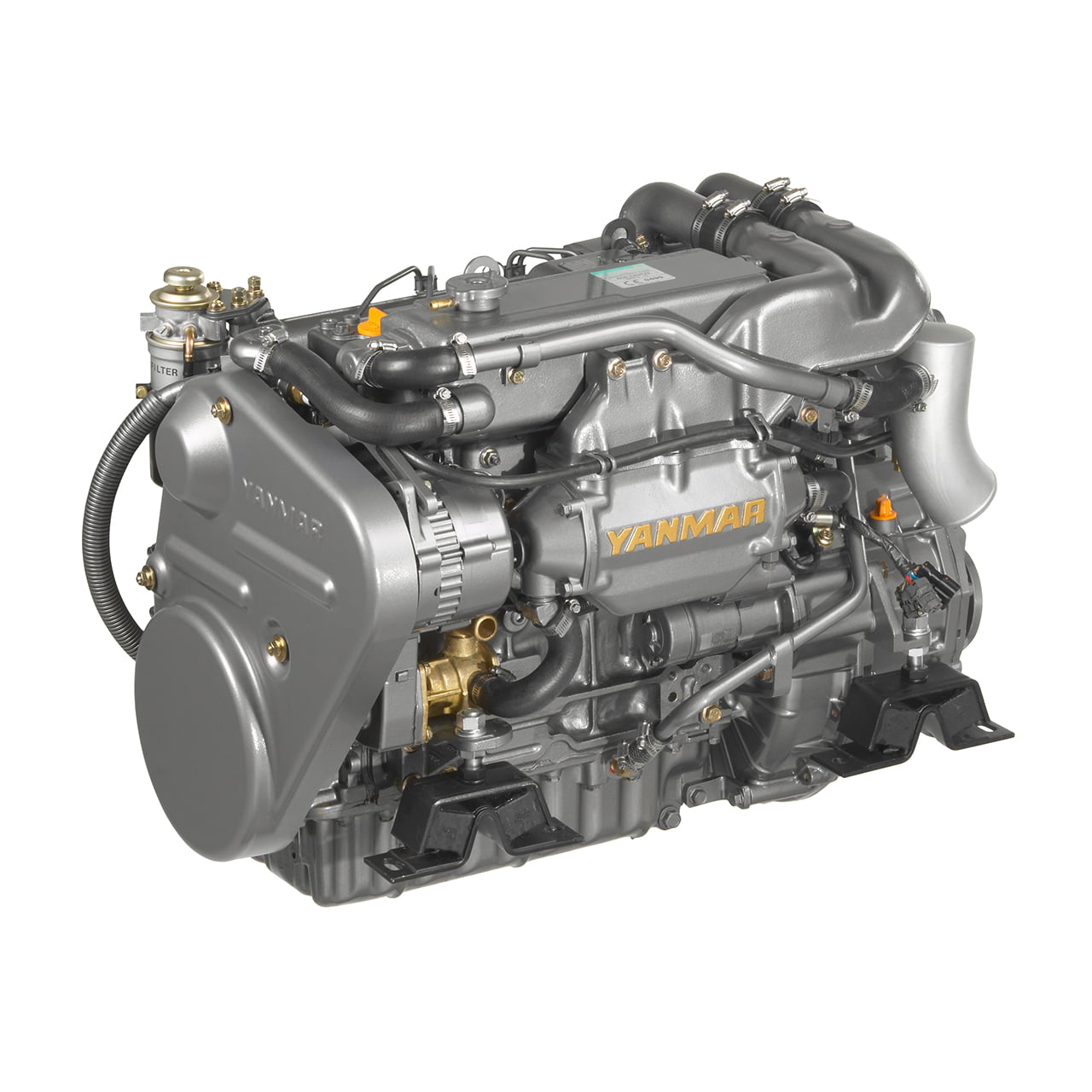
Green Energy Technology
All 220 V electric consumers on board have already been replaced with highly efficient appliances A++ or better. Some have to be re-wired and connected to the two inverters, rated 4000 W each, supplying 220V AC and 12V DC from the 48V battery banks. So, on a normal day, we will top-up our batteries and use a mix of our electric consumers. A smart control system is displaying the power generation, the capacity of the batteries and the overall consumption in real time. All lighting throughout the vessel to be LED. The two battery banks come with a weigh of around 600 kg, and have to be wired with suitable – meaning thick – cables to the inverters, the engine bays and charge controllers. Their charge level, temperature and other parameters are monitored and controlled by sophisticated electronics. A fully encapsuled 11 kW generator will serve as an emergency back-up system and a range extender for those unfavorable days without sufficient sunlight or wind. The generator may run on renewable/carbon neutral fuels as soon as they are available in the marinas. We are about to reduce the capacity of our two diesel tanks from today 700 liters down to 300 liters.
We will be operating our entire hotel load via renewable energies in the Med around 6 to 7 months per year. The generator might be running for 3 hours per week in order to top up the batteries if excessive power is drawn from the batteries or if unfavorable conditions apply in our area. In the Caribbean and Tropics, the generator will be hardly used at all. The owners of a Lagoon 620 reported, that they are producing their energy from 7000 W solar panels whilst cruising in the Caribbean and haven’t run their generator for months, but still keeping their diesel engines. With our Catamaran, are going one step further. With our customized Green-Energy-Technology-Package, will be able to E-motor for up to 3,5 hours at a speed of 6 knots, and a range of approx. 22 nm on our batteries only. This is sufficient for the most part of our cruising. In case we are forced to motor even further, or more power is required, the generator is switched on and is providing the required extra energy plus recharging the batteries. In this scenario we have a range of more than 1000 nautical miles at a speed of 6 knots.
The installation and integration of the Green-Energy-Technology-Package requires full access to the existing ships infrastructure, such as wiring, plumbing and communication. Therefore, we removed all wall- and ceiling cladding, the cabinet doors and back walls and much more. All electrical 220V and 12V components and consumers on board have to be energy saving A++ or better.
Unnecessary equipment, furniture and cabinetry as well as a partition wall (non-structural) have been removed from our Catamaran in order to reduce the overall weight. Reducing the overall weight of the vessel is reducing the wetted area of the hulls, which is increasing the hydrodynamic performance. By placing the new, heavy components near the mast, the wave action of the vessel will be more pleasant and stress on the integral structure is reduced. Parallel to this, the entire interior is about to be refurbished and adapted to our requirements with a spacious design approach and a bright color scheme. ENTROPY is a owner’s version with three cabins and three bathrooms only, providing a lot of storage and space inside and out.
In order to further increase our autonomy from fossil fuels, the solar energy production will be ramped up, exceeding 7000 W, by installing additional flexible solar panels to the outside of our hulls. They are harvesting the indirect light and reflections from the surface of the water. The efficiency of thin film/flexible solar modules is lower compared to the rigid panels, but the huge area is resulting in a significant contribution to the overall renewable energy production.
Twin electric Oceanvolt drive motors with sail drives and pitched propellers are installed instead of the diesel engines with drive shafts. They are coming at a weight of around 200 kg each, gearboxes are no longer required. The new electric motors are water cooled and when sailing, the propellers are recuperating electric power with high efficiency. In order to install the sail drives, the existing drive shafts, sealing, supports and engine mounts have to cut and removed. New penetrations for the electric drives have to be cut into the hulls and laminated in order to regain structural integrity. The sails will be redesigned and the sail-area is increased. A new mainsail with a square top and an additional code-zero/asymmetric spinnaker plus two new furling-foresails will make the vessel faster and more adapted to all types of prevailing wind-scenarios. As a result, we will be sailing more often and motor less. The increase of the overall, all-year average boat-speed is increasing the amount of energy produced by the hydro-recuperation when under sail.
The bow and stern waterline sections of the hulls will be modified and reshaped with fiberglass, epoxy-resin and foam-core materials in order to improve the hydrodynamic performance of the vessel. Even slightly increasing the average cruising-speed of our Catamaran is resulting in a significantly higher rate of recuperation. A long-lasting copper-coat hard paint will be applied to the bottom of the hulls, reducing the need to haul-out and renew the underwater paint every year. It requires cleaning by hand/brush whilst at anchor from time to time depending on the growth rate of the barnacles and the bio-film. As a result, the amount of antifouling paint and environmental pollutive substances in the ocean and on land, at the boat yard will be reduced. The multiple layer copper-coat is supposed to last a minimum of 5 years.
Small air-conditioning units with sea water-cooling will be integrated into the three cabins and the salon, powered by the surplus of solar energy produced during the hot summer months. They will cool and de-humidify the ships interior around midday and in the evenings. In fact, Going Green doesn’t necessarily mean that we are losing comfort on our Catamaran.
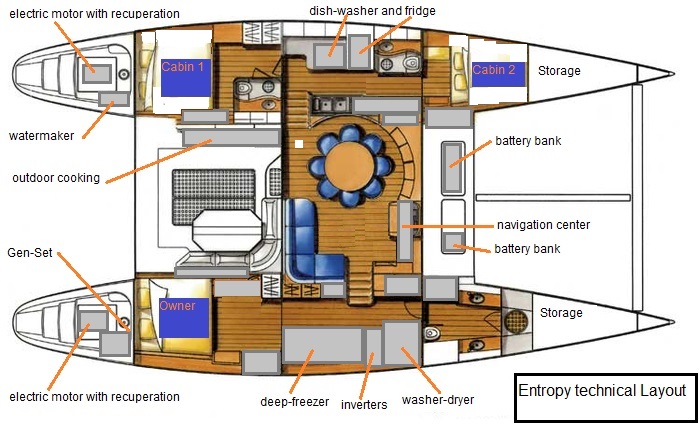
Green Energy Sailing Examples
- – Day-trip, one hour of motoring out of the marina and 3 hours of sailing with hydrogeneration, plus solar and wind will result in fully charged batteries in the evening.
- – Sailing longer passages, day and night with hydro-recuperation, some motoring in-between, plus solar and wind will result in gaining almost fully autonomy. We will be in the position to cross the Atlantic Ocean literally without burning any fossil fuels. Only if the wind dies completely and there is no sufficient sunlight in the daytime, the generator might be required to top-up the batteries.
- – At anchor, we will be using around 10 to 14 kWh for the hotel load whilst the solar and wind are generating something between 10 to 18 kWh per day. As a result, our energy balance is positive and we are recharging the batteries as well.
- – When motoring, our twin electric motors will propel the catamaran at 6 knots for about 3 hours in the absence of opposing wind, by drawing the required power from the battery banks. If required, the generator is switched on and our range is extended to 1000 nm at 6 knots and recharging the batteries at the same time. The fuel consumption is around 3,5 liters per hour. The genset will run on biofuels or other carbon neutral fuel as soon as they are available in the marinas.
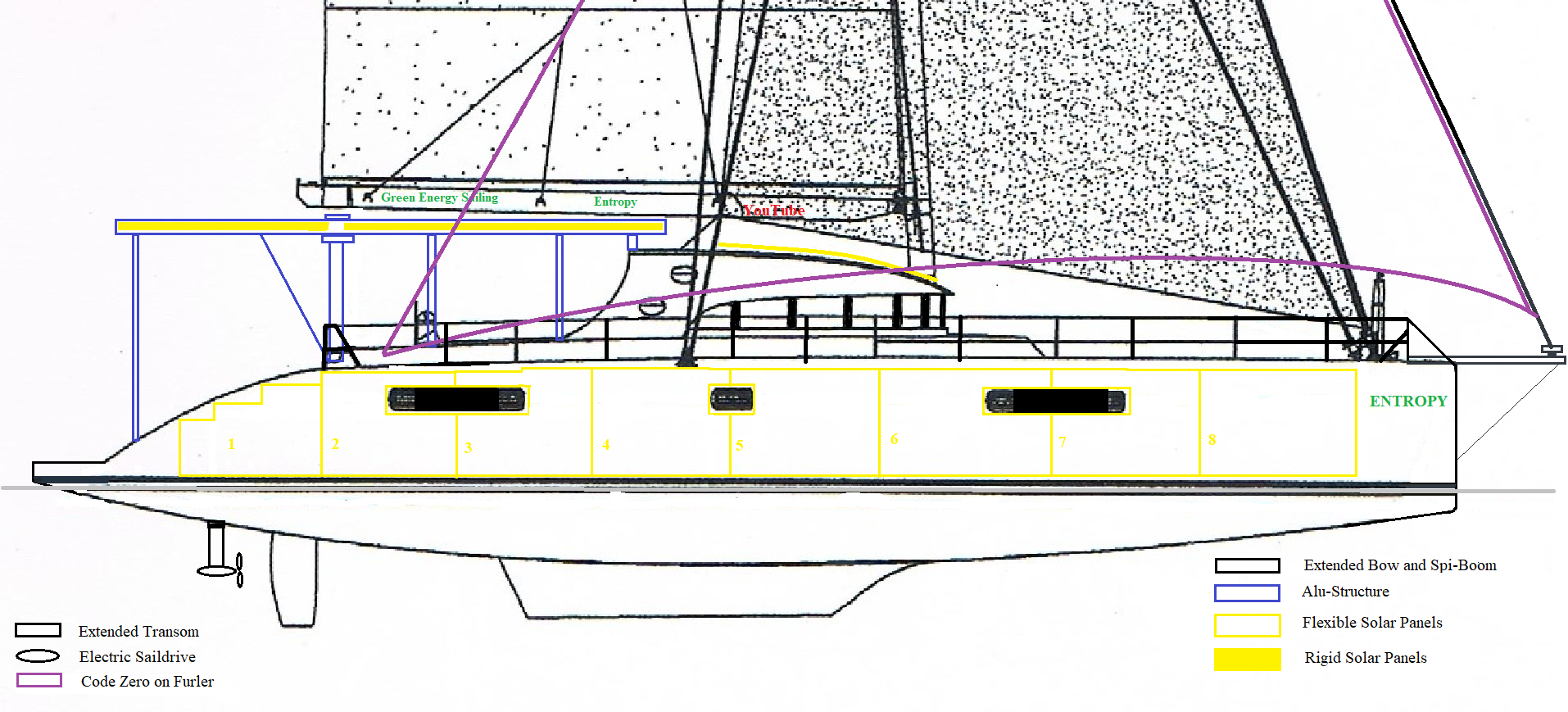
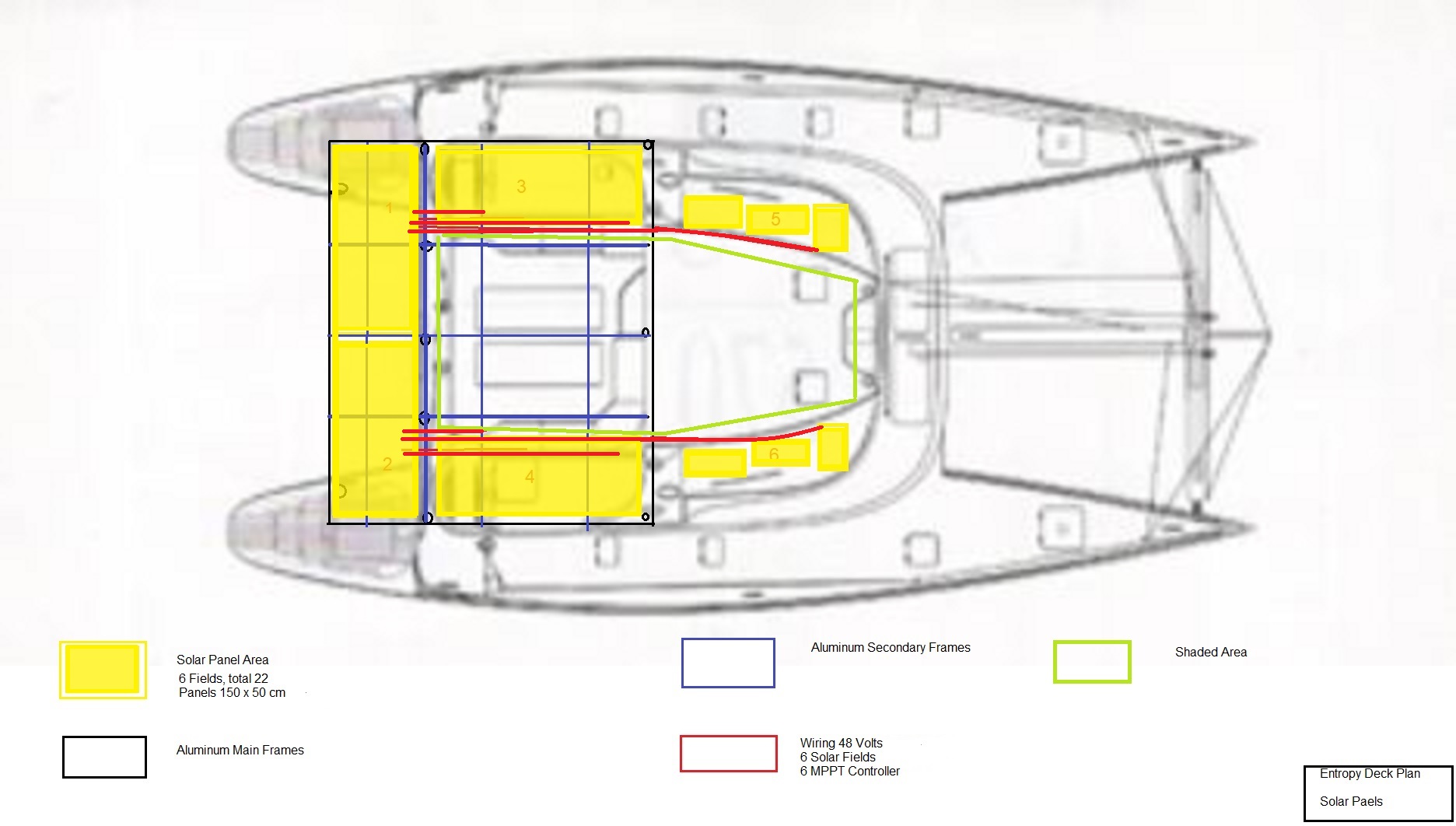
ENTROPY is an owner’s version and her layout consists of two double cabins only, each with its own shower-room and electric toilet located in the port (left side) hull of the catamaran. The beds are 1,80 x 2,00 meters with slatted frame and foam-core mattresses and the cabins are bright and well ventilated. They are equipped with fan and AC, providing ample space and storage. They are separated by the galley with a cold kitchen, dishwasher and fridge. The starboard (right side) hull is occupied with a huge top loading deep-freezer, washing-machine/dryer and a lot of storage as well as our cabin and shower/toilet. The salon and fully shaded cockpit serve as socializing/entertaining and dining area.
The cooking and BBQ is located outdoors as well. Two huge trampolines between the bows are perfect for sunning and observing the sea when sailing. The two transoms allow easy access to the water and boarding the dinghy. There is an abundance of space and privacy on board, making sailing with ENTROPY a very comfortable, exclusive and memorable experience.
The Planned Rebuild
Our catamaran is perfect for installing rigid solar panels, we do this by using the free space above the dinghy and enlarging the existing bimini StB (right) and BB (left). Rigid (non-flexible) solar panels have a higher efficiency compared to flexible panels. Flexible panels are installed on the curved surfaces of the cabin roof. We plan to have a total output of 4500 watts, which will be fed into the battery bank via MPPT charge controllers. We plan to glue flexible solar panels on the outer sides of the hulls to achieve 6000 watts/p.
Wind power on board is not as productive as the solar panels because the size of the propellers are limited. We will install 2 wind turbines of 350 W each at the stern. These will also charge the battery bank via charge controllers.
We will install a small encapsulated diesel generator which will act as an emergency back-up to charge the batteries in winter, dead calm, rain and storms. The generator may operate on renewable/bio fuels in the future.
The new electric motors (30 kW each) replace the diesel engines, 110 kW each. The drive will be converted from shaft with folding propeller to saildrive with fixed propeller to enable hydra-recuperation. Due to the high efficiency of this system, a lot of electrical energy is produced when sailing.
Our three sails are about 10 years old and are at a sailmaker for inspection. We plan to have lighter and more effective sails made to increase the efficiency as well as the sail area. With these new sails our catamaran will sail 2-3 knots faster and therefore generate much more energy via recuperation.
The Roadmap
2022 – 06
– cleaning and sanding the bottom and keels
– removing the chart-table, furniture, and electronics in the salon
– removing the gas oven, gas cooker and piping, gas-bottle locker
– removing a non-structural partition-wall and door, Port Hull
– removing all cabinet doors, back-walls, and wall/ceiling cladding
– extending the galley and counter tops cabinetmaking, new furniture
– removing the Port front cabin furniture
– removing the Port hull skipper cabin
– removing twin 110 hp Yanmar turbo diesel engines
– lamination works and Epo-Gel coating both engine bays
– removing the Jacuzzi and bathroom furniture, cladding StB
– cleaning the 2 x 500 liter water tanks and bilges
– disassembling and removing the Onan generator from the front locker
– lamination works regarding the escape hatch in the Port skipper’s cabin
– extracting and removing furniture from the two aft cabins and office
– stepping the 22m Marechal alloy mast for service and paint job
– lamination/epoxy works Port forward cabin
2023 – 01
– lowering the anchor and 60meter s/s chain
– removing the two inverters, wiring, fuses from StB office
– removing outdated electrical equipment, TV, speakers, amplifiers
– installation of a temporary battery charger StB
– rewiring the 220 V AC shore power supply
– lamination works and new support for the water-maker
– lamination works and Epo-Gel front compartments
– installation of the Green-Energy A+++ Whirlpool top loader deep freezer
– installation of the Green-Energy A++ Liebherr fridge
– arrival of the new halyards and s/s shrouds for the main mast
– arrival of the Miele A+++ cloth washer and Miele A++ dryer
– arrival of the Schenker Zen 100l/hour water-maker
2023 – 06
+ Interior joinery works
+ Removing and renewing wall claddings
+ Reworking galley cabinets, shelves, and cladding
+ Rewiring and upgrading the 220V AC and 12V DC systems for the Green Energy Package
+ Sanding/Sandblasting and paint job of the Mast, Boom and bow traverses
+ Renewing the wooden steps of the catwalk
+ Disassembling the existing Bimini and hard top main sail traveller, car, rollers and supports
+ Installation and wiring of the Green-Energy water-maker into the engine bay
+ Welding and fixing the new aluminum Bimini structure for the solar panels
+ new Harken main sail traveller on top of the Bimini, new hardware, blocks and supports
+ Joinery works, furniture and storage cabinets in the former office StB
+ Installing Green-Energy Miele A+++ Cloth-Washer and Dryer
+ Deep-Freezer StB housing and cladding
2025 – 01
+ Joinery and woodworks in the StB Bathroom
+ Bathroom & Shower StB
+ Fixing the Green-Energy-Package rigid solar panels on top of the new Bimini hard top
+ Fixing the Green-Energy-Package flexible solar panels on the rooftop
+ Removing both rudders for service and renewal of the shaft seals/bearings
+ Engine room, removal of engine foundations, fuel filters and lines, wiring, exhaust system
+ Removing the drive shafts, the supports, and the folding props
+ Lamination/Epoxy-works for the Green-Energy electric propulsion and mount for driveshaft
+ Water pipes and shower unit StB
+ Grey water and sum pump installation
+ Paint job bilges Port with Epogel
+ Shower cabin epoxy filler and paint job of shower cabin
+ Paint job bilges StB with Epogel
+ Joinery and woodwork in the StB Bathroom
+ Removing the trampolines
+ Sandblasting the aluminum Parts and rails
+ Sanding and paint job aluminum Parts and rails foredeck
+ Installation catwalk wooden flooring
+ Checking und upgrading the wiring and navigation electronics of the mast
+ Changing all exterior lights (Mast and Navigation lights) to LED
+ Inserting new lines and halyards into the mast
+ Sanding, degreasing and 2K Epoxy paint job of the new Bimini structure
+ Stepping the Mast and installation of the new s/s shrouds and halyards
2026 – 01
+ Wiring the Green-Energy-Package to the MPPT-controllers, battery banks and switchboard
+ Installing two Victron Inverters and the Li-Battery bank for the hotel load
+ Running wires from and towards the two Green-Energy Li-Ion battery banks
+ Connecting the Green-Energy-System to the existing on-board system
+ Installing and wiring 2 Wind Turbines
+ Installation and wiring of the 2 Green-Energy electric drive motors/sail-drives
+ Installation of the Green-Energy motor battery bank
+ Water tanks, water sensors and gauges
+ Wiring of the additional Green-Energy motor battery bank and twin throttle controls
+ 220V and 12V USB outlets in cabins and salon, nav station
+ Replacing all hull throughs and valves
+ Exchanging 12Volt Pumps against energy efficient systems
+ Installation of 12V LED-lights throughout the vessel
+ Raymarine Sea-Link update, rewiring and 3rd monitor at the nav-station
+ Removing and renewing the ceiling cladding Stb and Saloon
+ Installation of the Green-Energy auxiliary genset
+ Installation of 4 AC-Units to the 3 cabins and salon
+ Cabinet making, beds, shelves forward cabin
+ Storage room BB bow (former skipper cabin)
2027 – 01
+ Storage room StB
+ Renovation of 2 Bathrooms
+ New energy & water saving electric toilets, black water system, valves and piping
+ New powerful 12V bilge pumps for the 6 watertight compartments
+ Completion of galley BB, installation of Miele A++ dish washer
+ Epoxying kitchen and bathroom countertops
+ Saloon entertainment-system and TV, WIFI, Keyboard, Nav-Station
+ Epoxyworks transoms, extended waterline with reversed bow Stb and Port
+ Making the new outdoor cooking station in the cockpit
+ Installation of A ++ hot-air oven, induction stove, griddle plate and sink
+ Installing the Code zero pole, supports and roller furling
+ Cabinet and wall paint jobs BB, Stb and Saloon, sliding door and windows
+ Application of barrier coat and environmental friendly Copper Coat Antifouling
+ Fixing and wiring the flexible solar panels to the outside of the hulls
+ Navigation electronics, reconfiguration, check-up, and updates
+ Polishing of acryl windows, hatches and portholes
+ Fixing new trampolines and bean bags
+ Finishing soft furnishing and beds
+ Sanding and oiling the cockpit teak
2028 – 01
+ Replacing the transom teak flooring
+ Wiring the Green-Energy-Package power management & controls, and monitor
+ Completion engine bay, chain-locker, and storage compartments, final paint-job
+ Completion exterior soft furniture
+ Completion Harken electrical winches and Lofrans windlass, service and repair
+ Completion exterior paint job with top coat
+ Completion machine polishing of the Stainless-Steel, aluminum parts and Gelcoat
+ Completion dinghy and davits, Harken rollers, blocks, rails, cars, winches, anchor, chain
+ Completion installation of new sails, battens, sail bag, lazy-jacks, and code zero
+ Completion check-ups, snagging and adjustment, touch-up
+ Splashing ENTROPY
+ Sea trials and tests
+ Final check-up and fine-tuning of the Green-Energy-Package, the battery management, the electric
propulsion system, the navigation-systems, and integration of all on board systems and consumers
2030
+ Starting from end of September, we are ready to go.

FAQ
What happens to my money
Your money will be used for the realization of the Green-Energy-Package, as explained on our website, such as purchase and installation of rigid solar panels.
As a bonus, this amount will be returned to you on the occasion of booking a sailing trip on our official website.
Question 2 - How can I make a booking with you?
Question 3 - Why should I support you?
Our dream is to sail guilt free (in regards of planet pollution), if you also dream of a guilt free vacation time, then this is the right project for you.
Question 4 - Are there already comparable projects?
Question 5 - How much space do you have on your catamaran?
Question 6 - You want to go green, so why are you installing a diesel generator?
Question 7 - What does sustainability mean for you?
For this reason, we use an already existing catamaran to be customized for our requirements.
